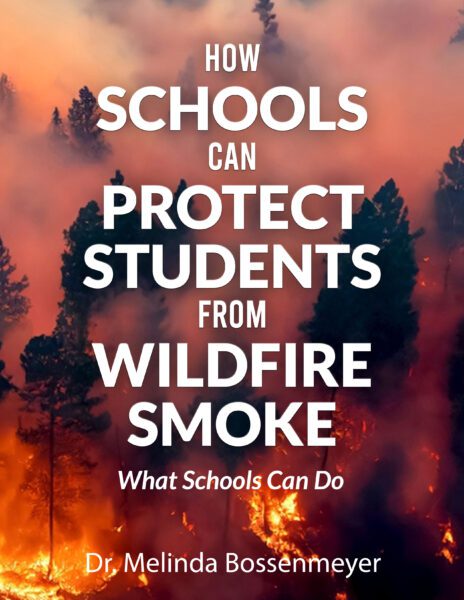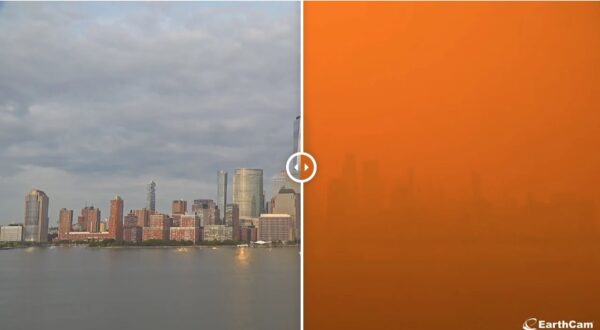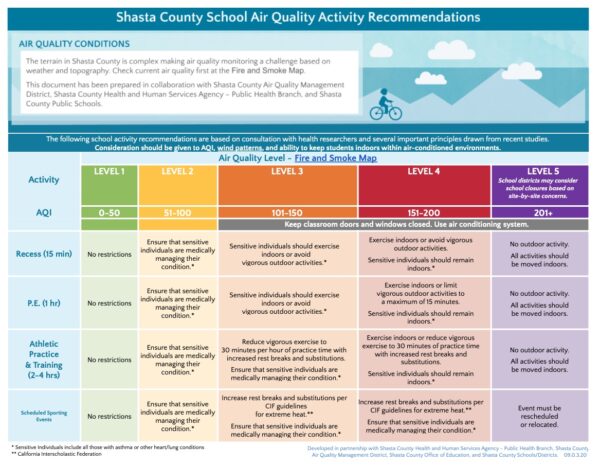How Schools Can Protect Students From Wildfire Smoke
By Dr. Melinda Bossenmeyer, The Recess Doctor

Spreading from CA to Across the U.S.
California schools have dealt with the issue of wildfire smoke for a number of years. However, now wildfire smoke is a growing problem across the United States (and even the world at large), and schools are on the front lines. When smoke levels are high, schools may need to close or take other measures to protect students’ health. Wildfires in the West have set records for their severity and resulted in darkened skies for weeks at a time, resulting in unhealthy air outdoors and inside. Regrettably, this risk is only expected to rise as temperatures rise resulting in dry conditions and severe fire warnings. Climate change rears its ugly head.
The problem is not only limited to outdoor air.
CA First ( a climate monitoring service) has shown that tiny particles in smoke go deep into the lungs, increasing the risk of asthma for children and heart attacks and strokes for adults. One scientific study, according to NPR, found that wildfire smoke is even more dangerous than pollution from cars or trucks.


“Literally no amount of exposure is safe,” said Marshall Burke, an associate professor of earth system science who led the project for Stanford University. Emerging research shows wildfire smoke exposure not only negatively impacts the heart and lungs but also the brain. Smoke exposure also poses pregnancy risks. Children and older people are most vulnerable. “There’s no magic threshold under which we’re OK and beyond which we’re in trouble. The lesson is that any amount is bad. And the more you get the worse it is.” To help to understand smoke and particles you need to understand how air quality is monitored.
What is the Air Quality Index
To begin to understand Air Quality and how it is affected by smoke, a good place to start is the Air Quality Index. The air quality index is helpful in identifying air quality anywhere in the U.S.
Although my family and I live in southern California, we planned to visit Kona, Hawaii in the summer of 2018. In May 2018, the air quality report due to the volcano eruption near the city of Puna on the island of Kona was in the unhealthy zone (201-300) and it stayed at that level for a month after the initial eruption.
As July 2018 approached, we keep an eye on air quality and found that it had improved substantially, landing in the moderate range most of the time.
This scenario points out a couple of issues to keep in mind. When the fire is finally put out, the air quality usually returns to normal. Air quality is also affected by wind gusts, rain, or other environmental factors. So, air quality is a moving target. Constant monitoring is necessary to keep on top of current conditions.
Air quality index
0–50 Good
51–100 Moderate
101–150 Unhealthy for sensitive groups
151–200 Unhealthy
201–300 Very unhealthy
301+ Hazardous
Data updates every three hours. Last update: June 10, 2023 at 8 a.m. local time

How do you check Air Quality in your Area?
Monitor Air Quality: https://www.airnow.gov/
The easiest way to check for air quality anywhere in the U.S. is to use the EPA’s Current Air Quality monitor. It is as simple as visiting the website and entering your zip code. In the diagram above, I entered my zip code in Southern California and our air quality today is good as you can see.
Understand the Air Quality index: https://www.airnow.gov/aqi/aqi-basics/
Now that air quality and how to monitor it has been explained, we move on to the purpose of this article: How should schools deal with smoke caused by wildfires?
Some lessons learned from CA
Here are some things schools can do to protect students and learn to live with wildfire smoke:
Monitor air quality. Schools should monitor air quality and evaluate closing when levels are unhealthy. The Air Quality Index (AQI) is a good way to track air quality. The AQI ranges from 0 to 500, with levels of 100 or higher considered unhealthy. You can monitor it here by inserting your local zip code. :https://www.airnow.gov/
Some households in California installed indoor sensors to track air quality levels. Researchers at the University of California Berkeley studied the data from 1,400 sensors in San Francisco and Los Angeles and found that even indoors, air pollution tripled during the fires.
The lesson: just going inside isn’t enough. Invisible particles in smoke, known as particulate matter or PM 2.5, can seep in through doors and cracks in windows.
Still, researchers found the households that took action fared much better. Those that closed their windows, had air purifiers, or ran central air conditioners had lower levels of indoor pollution.
Have a plan in place realizing the children are particularly vulnerable to the effect of wildfire smoke. This is partly due to children’s increased activity levels. Schools should have a plan in place for what to do with students when smoke levels are high. This plan should include information on how to keep students safe, such as:
closing the school when necessary,
moving classes indoors,
mandating indoor recess and physical education,
As was the case during COVID-19 in some schools providing air purifiers in classrooms may be another option.
Communicate with families.
For administrators, making decisions about canceling school or keeping children indoors for a long period of time, is bound to get parents’ attention.
So, schools should communicate with families about air quality and resulting health concerns in a proactive way to communicate the school’s plan for “keeping students safe”. This communication should be clear and easy to understand.

Resources for Schools.
-
- California has developed a set of resources for schools called: Air Quality Guidance for Schools. You can download their guidelines here. https://www.cde.ca.gov/ls/ep/documents/airqualityguidance.pdf
- Shasta County in CA has a similar set of guidelines called Shasta Air Quality Levels and Guidelines. Download Shasta Guidelines https://www.shastacounty.gov/sites/default/files/fileattachments/air_quality/page/2400/aq-levels-guidelines.pdf
-
- Another resource is from the EPA – Create a Clean Room to Protect Indoor Air Quality during a Wildfire. https://www.epa.gov/indoor-air-quality-iaq/create-clean-room-protect-indoor-air-quality-during-wildfire
Provide resources for parents. Schools can provide resources and information to families.
-
- Revisit COVID-style masks for especially vulnerable students.
- Provide information on how to check air quality: https://www.airnow.gov/
- Wildfire Smoke Fact Sheet-Creating a Clean Room at Home. https://www.airnow.gov/sites/default/files/2022-02/how-to-create-a-clean-room-at-home.pdf
Provide resources for parents.
Schools can provide resources and information to families.
Revisit COVID-style masks for especially vulnerable students.
Provide information on how to check air quality: https://www.airnow.gov/
Wildfire Smoke Fact Sheet-Creating a Clean Room at Home. https://www.airnow.gov/sites/default/files/2022-02/how-to-create-a-clean-room-at-home.pdf
Here are some additional tips for schools:
Keep windows closed. When smoke levels are high, keep windows closed to prevent smoke from entering the school.
Run the air conditioning. If the school has air conditioning, run it to filter out smoke.
Use air purifiers. Air purifiers can help remove smoke from the air.
Post signs about air quality. Post signs around the school to remind students and staff about air quality and how to protect themselves.
Provide breaks for students. If smoke levels are high, provide students with breaks to go outside and get fresh air.
Be flexible. The situation may change quickly, so be prepared to adjust your plans as needed.
By following these tips, schools can help keep students safe from the harmful effects of wildfire smoke.

